Guzmania: description of species, transplantation and care

Many flower growers, wanting to decorate their home garden on the windowsill, acquire evergreens that can give a spring mood even in winter cold. The representative of the Bromeliad family - the guzmania flower, just fits this description. Its spreading leaves and vibrant bracts fit perfectly into a home greenhouse.
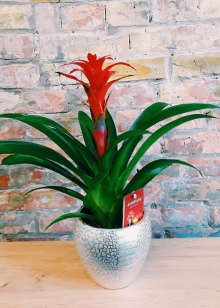
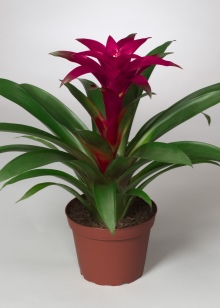
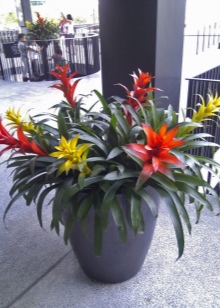
Description
The guzmania flower owes its name to the famous Spanish botanist Anastasio Guzman. It was he who, in the 18th century, provided the first description of the represented plant. In everyday life, the name of a flower is pronounced through the letter "s" at the beginning of the word, although it is more correct to pronounce "z". The homeland of Guzmania is Latin America. The flower grows in tropical forests on the bark of mature trees. Sometimes it can be found on tree stumps.
Guzmania is an epiphyte, since the plant receives the necessary moisture and the required nutrients directly from the air space. The family tree of Guzmania has about 150 epiphytic species that grow in forests and on mountain slopes. They are quite common in Brazil, Central and South America, as well as in Venezuela and Florida.
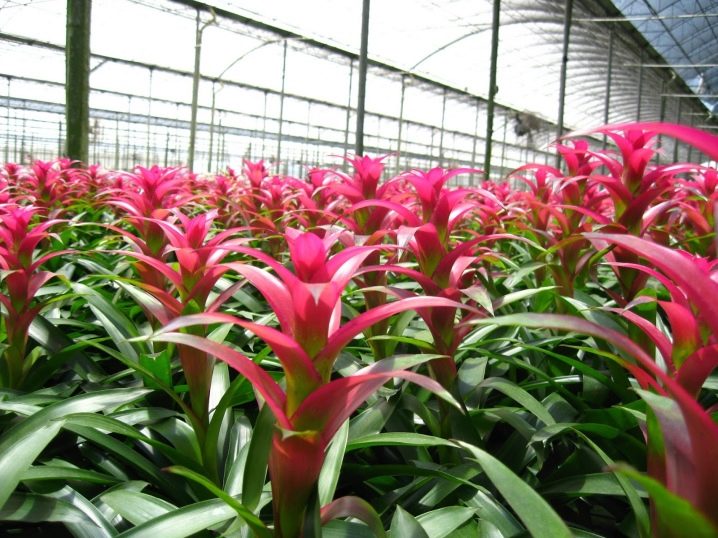
Unfortunately, only some of their representatives have adapted to the room conditions of detention.
Epiphytic roots are rather weak. Their main task is to attach the plant to the bark of trees. Sometimes the roots of a flower can catch on cracks in rocks of rocky heights.
There is no stem in the structure of the guzmania. Elongated and narrow in width, the leaves are compressed rather tightly at the base of the flower, thereby forming a rosette that resembles a tall glass in shape. In the wild, this form easily collects rainwater and morning dew, which are an alternative to moisture sucked out of the air.
In the central part of the leaf rosette, a peduncle is formed. It consists of small leaves, and at the top is bright red bracts. Sometimes it is yellow or orange. In guzmania grown artificially, the bracts can be lilac or purple. The bright colors of the bracts call in insects that contribute to pollination.

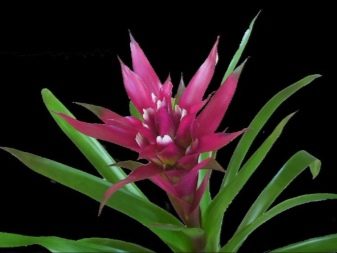
Each separate species of guzmania blooms at different times of the year. The duration of this process in some cases reaches six months.
Types and varieties
Unfortunately, only some varieties of Guzmania have been adapted to the room environment, but even this small amount can change the general appearance of the mini-garden, complementing it with grace, beauty and spring warmth.
Further, it is proposed to familiarize yourself with those varieties that have managed to take root in a home environment.
- "Reed". In terms of its dimensions, the plant is quite large, due to which it is the pride of the collection of any grower. The maximum length of bright green leaves is 50 cm. Their reverse side is decorated with brownish stripes. Despite the slight spreading of the leaves of the flower structure, their dense structure forms a solid rosette at the base of the plant, designed to collect and store liquid. The peduncle is small in size. Its leaves can be red or orange. The flowers in the central part of the peduncle are dwarf in size and yellow-white.The flowering period lasts for three weeks. At this time, the flower takes on a majestic appearance. After the time allotted by nature, the central part of the flower becomes faded and withers, but, despite this, the guzmania continues to live, highlighting daughter rosettes.
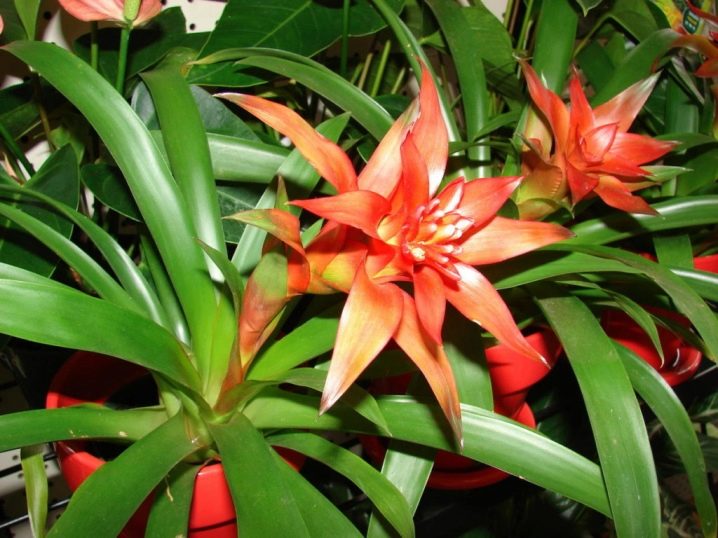
- "Minor". In the botanical environment, this type of flower is called "Minor Rondo". The presented epiphyte is an artificially bred hybrid of the "Yazychkova" guzmania. A distinctive feature is its compact size. Guzmania "Minor" is quite often found in mini-home gardens. And it's not only about the size, but also about the bright colors of the plant. Its flowering period begins in February and ends in August. The process is accompanied by the maximum opening of the bright red petals of the peduncle, inside which small white flowers appear.
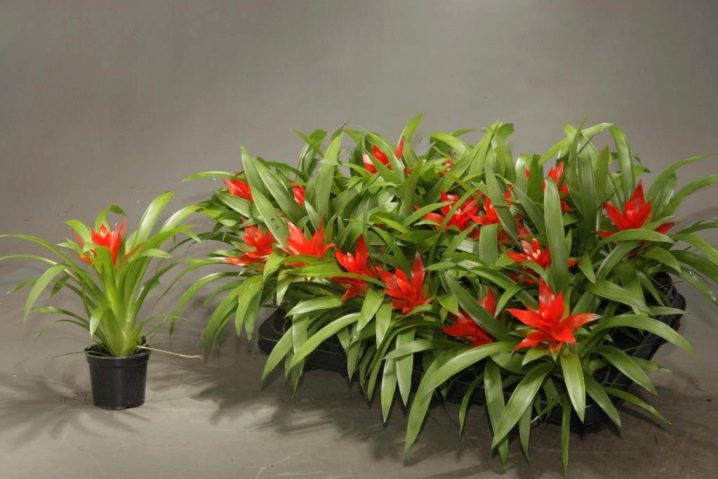
- "Tempo". In terms of its characteristics, the plant is very similar to the "Minor" variety, the only difference is its size. Spreading bright green leaves, due to the dense structure at the base, create a solid rosette. A bright peduncle, often red in color, is complemented by white blotches on the leaves.

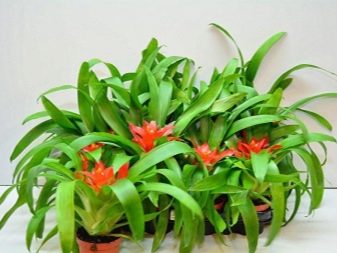
- "Mix". In flower shops, this type of epiphytes is quite common. The peduncle of a plant can be yellow, pinkish and even burgundy. You just need to make a choice in favor of a particular variation. Guzmania "Mix" was created by breeders by crossing different types of flowers, due to which the plant takes root well at home. By their nature, they are unpretentious, and their appearance makes the mini-kindergarten especially attractive all year round.
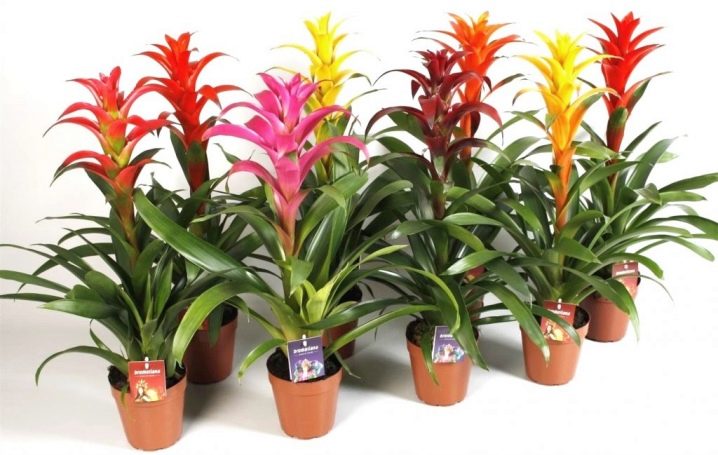
- "Nicaraguan". Due to its small size, it is ideal for growing in apartments. The dense rosette consists of 16 tongue-shaped sheet plates. The leaves at the base of the flower are wide, tapering to the tip. Their surface is slightly rough to the touch. In appearance, the plant resembles an upright spikelet. In the central part of the peduncle there are small lemon-colored flowers sitting on short petioles. The flowering process of the "Nicaraguan" guzmania mainly occurs in the spring and lasts for several weeks.

- "Konifera". In the presented species, the rosette is made of dense and elongated sheets of dark green color. At the end of the summer period, a cone-shaped scarlet inflorescence with an orange edging of petals forms at the top of the flower, which attracts attention. In nature, "Konifera" is considered a large epiphyte that grows on the trunks and branches of tropical trees. The plant collects moisture required for survival from rainfall, and absorbs vitamins and nutrients from the air. Indoor guzmania "Konifera" grows very impressive in size, but despite this it is popular among many flower growers.

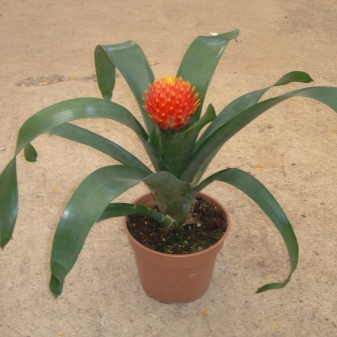
- Donnell-Smith. The presented variety is predominantly found in tropical areas. Quite often found in the mountains of Costa Rica. But, despite this, she managed to take root in a home environment. Florists are proud of this purchase, since bright bracts and yellow sepals bloom for six months, complementing the mini-garden with special beauty. The rosette of the Donnell-Smith Guzmania is composed of green leaves, the surface of which is covered with scales. The maximum length of the leaf plate is 60 cm, and the width is 3 cm. A distinctive feature of the Donnell-Smith guzmania is the possibility of self-pollination. Its seeds have a small tuft, which helps spread over long distances.
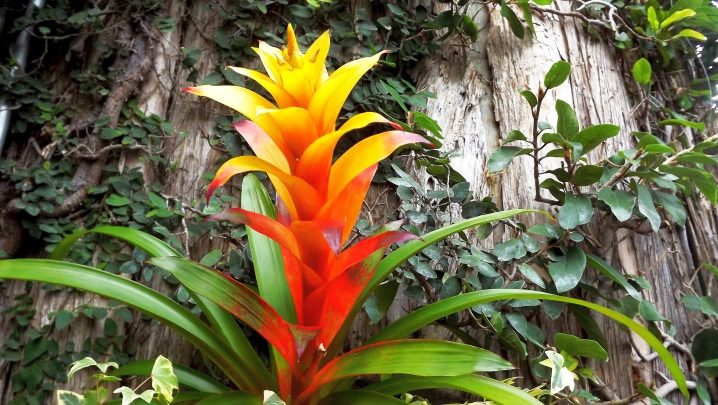
- "One-spiked". Quite an unusual ornamental plant. Its green leaves are complemented by yellow stripes. The flower resembles a spikelet in shape. The peduncle from the lower side is colored green, which, rising upward, flows into an orange hue.At the end of flowering and pollination, under the leaves, you can find small fruits collected in boxes. In the botanical environment, the "Odnokolosaya" guzmania is divided into three subspecies. The first one has monochromatic leaves. Its pale bracts are colored with longitudinal stripes. In the second subspecies, green leaves are covered with white stripes. The third subspecies provides a unique structure with a solid green foliage and a high inflorescence, which gradually changes the color of the bracts from its base to the very top.
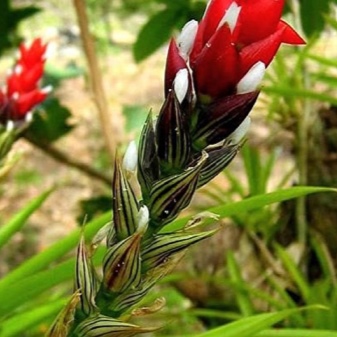
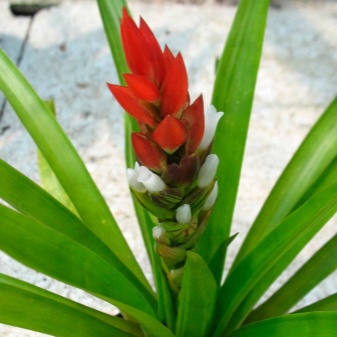
- Ostara. The presented plant variety is artificially bred. Guzmania "Yazychkovaya" and guzmania "Witmackii" are considered his parents. A glossy rosette of elongated leaves forms a dense base, on the surface of which red bracts are located. Artificial epiphyte blooms for a long time. Its decorative properties persist for six months, after which the flower dies. But with the help of daughter sockets, it can be propagated.
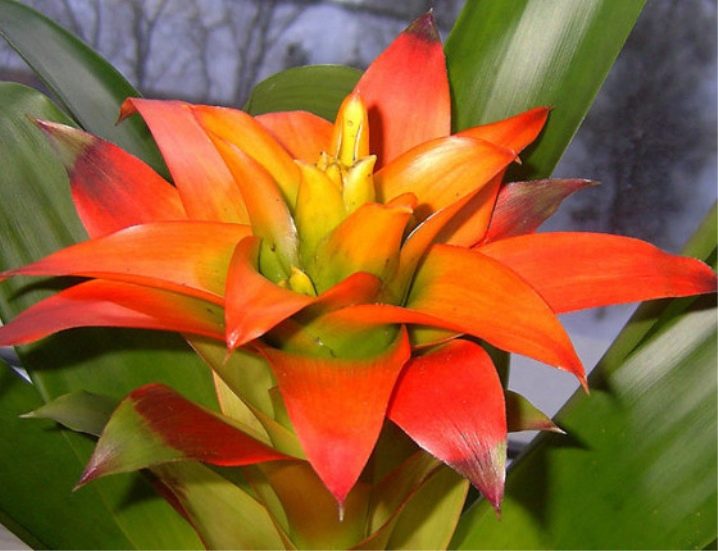
- "Blood Red". A distinctive feature of the represented type of epiphytes is the change in the color of the plant during the flowering period. In this case, not only short bracts are affected, the entire rosette becomes scarlet or purple. Guzmania also differs in its structure. The sheet plates are elongated. Their tips are bent down. The dense structure forms a solid base, reminiscent of the shape of an elongated glass. The height of the rosette is 30 cm. Yellow flowers are visible in its central part. With the accumulation of a sufficient amount of liquid, the feeling is created that these flowers are floating inside the structure. The blooming period of "Blood-red" guzmania is very long and lasts from April to August. After the plant dies.
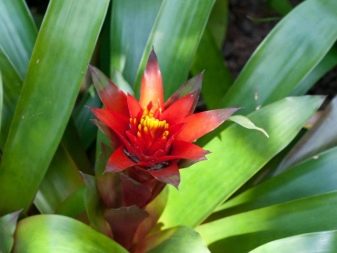

- "Tricolor". The presented decorative flower has a number of distinctive features. The main leaves of the plant and the petals of the peduncle are almost the same size. The color gradient flows smoothly from light green to scarlet. The view of the plant from above is simply mesmerizing. Small yellow flowers located in the center of the peduncle are especially striking.
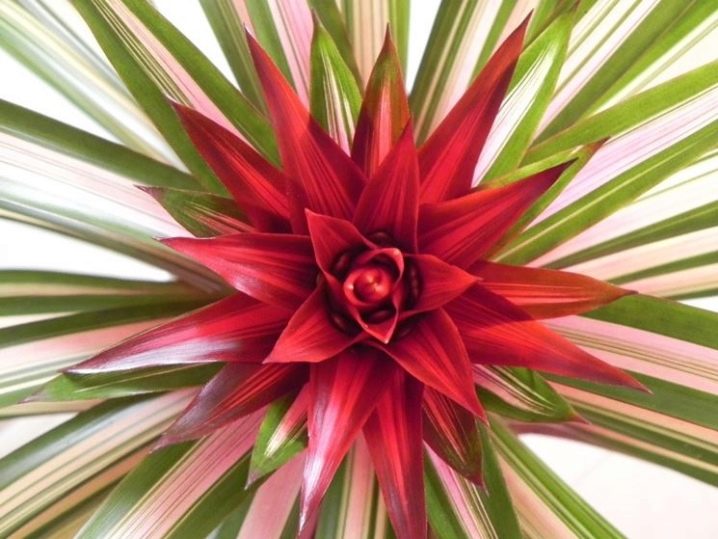
- "Mosaic". The flower is distinguished by an increased density of the rosette, on which there is a transverse pattern of light shades. The maximum sheet length is 70 cm, the rosette consists of approximately 22 sheets. Pink bracts attract rave glances. The flowering period starts in February and ends in July. The fragile root system of the "Mosaic" guzmania easily adapts to the soil. Subsequently, it draws out the necessary moisture from it and nourishes the plant.
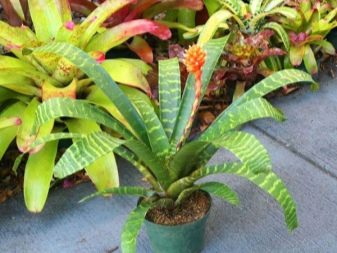
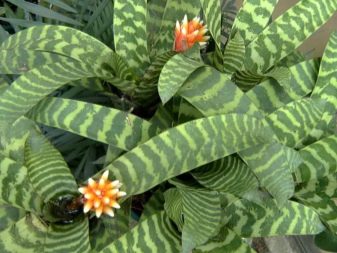
Home care
Indoor plants, like small children, require special treatment and careful care. According to its characteristics, guzmania does not belong to the list of picky plants, but still requires some attention.
In the wild, guzmania grows in shady zones. Adapted to the home environment, specimens also do not tolerate the scorching sun. Therefore, the plant must be placed in the eastern and western parts of the apartment. Undoubtedly, the guzmania needs sunlight, but it must be diffused. When bright rays hit the leaves, burns occur, due to which the plants lose their attractive appearance. The north side won't do any good either.
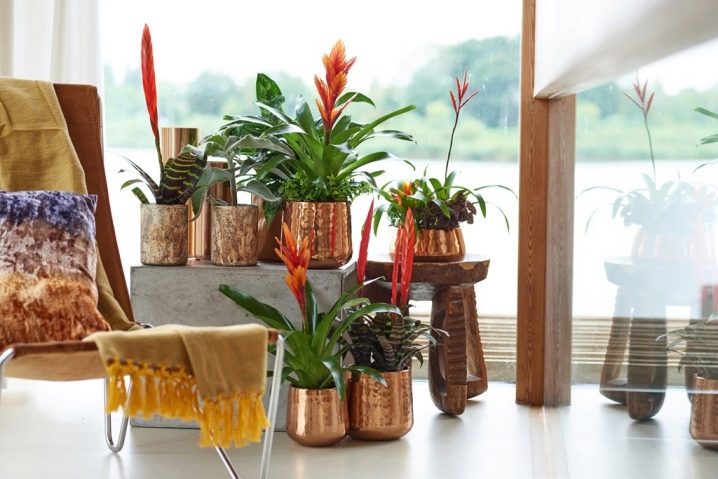
There will not be enough light, the petals of the plant bracts will fade, and the flower itself will lose its majestic appearance. Without changing its location, the guzmania will wither away.
In summer, the flower can be placed in the open air if you choose a corner for it that is protected from weather factors. During low solar activity, there is no need to protect the flower from the scorching sun rays. If it is not possible to take the flower outside, you will need to put it in a ventilated room.
Guzmania does not have a specific period of calm. Florists noticed that, on average, a flower's rest period fluctuates with the onset of cold weather, namely, from October to February. During the rest of the plant, watering should be reduced to the very minimum, do not spray the leaves, do not feed the soil. In this case, the maximum air temperature in the room should be approximately 20 degrees. In connection with the rest of the plant, the lighting should not be reduced, on the contrary, you can supplement it with a phytolamp, but do not forget to turn it off - the length of daylight hours should not be more than 9 hours a day.

The presented tropical epiphyte does not like hot weather and cold. The most comfortable temperature for the ideal state of the flower is a maximum of 25 degrees in summer, and 22 degrees during cold weather. A decrease in temperature below normal can lead to a lack of flowering, and in some cases the flower will undergo fungal attack.
The humidity of the room where the flower is located should vary around 60-80%. To maintain the required level of humidity, the air space must be sprayed with sediment water several times a day. In the dry season, you will need to install a container with clean water near the flower. The evaporated moisture will enter the air space, and the plant will absorb the evaporation due to the sheet wicking function. In some cases, it is allowed to wipe the sheet plates with a damp cloth.
In summer, it is customary to water the plants once a day before the onset of the peak of solar activity. Guzmania prefers daily watering of the soil composition in the morning or every other day by pouring the sediment liquid into the outlet. With the onset of cold weather, watering is reduced to once a week and exclusively in a pot. If you do not follow these requirements and moisturize the plant much more often, then it can get sick and soon die.
For irrigation, use warm water that has been settled for several days or has passed through filtration treatment.
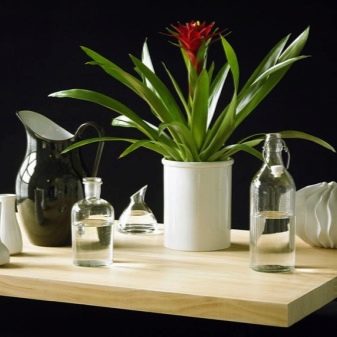

After the watering procedure, you need to wait a little time, then drain the excess liquid from the pan.
Various types of feeding help to properly care for the plant, especially during the growing season. In the wild, guzmania independently extracts minerals and substances, and at home, a florist must carry out top dressing. A valuable fertilizer for guzmania is considered to be a mixture made for the bromeliad family. In their absence, universal preparations will do, only the concentration for feeding should be reduced by 3 times.
It is enough to feed guzmania once every three weeks. The diluted mixture should be of a liquid consistency. And they pour it directly into the outlet. Watering the soil can damage the fragile root system.


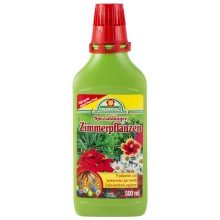
Transplant rules
Guzmania can be transplanted only once in a lifetime and only as a last resort. The purchased plant should be transplanted into another container immediately after purchase, since the transport soil is not suitable for its natural cultivation.
Guzmania roots are very small and fragile, therefore, when choosing a new pot, you should pay attention to the transverse length of the container. - it should not exceed 12 cm. The pot selected for transplanting must be made heavier so that, as the growth of the guzmania grows, it does not turn the container over. As an additional decoration, the container can be placed in a decorative planter. We must not forget about good drainage.
The soil mixture used for transplanting must pass liquid well. Soil for orchids and ferns is ideal.
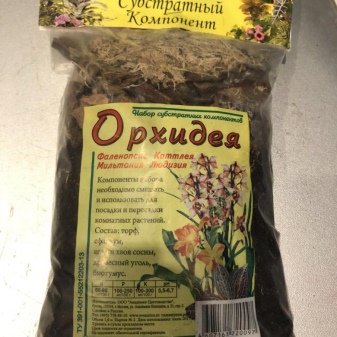
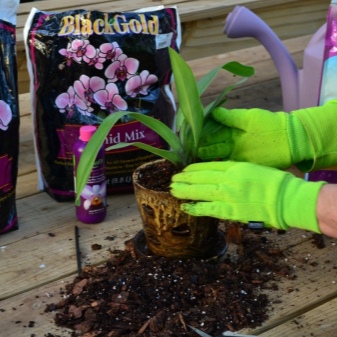
But the purchased mass does not always inspire confidence in the grower. As an alternative, an independent creation of a soil mixture is proposed. You only need to know the compound formula and the required elements. Mix options:
- one part of sand, two parts of leafy land, one part of moss and two parts of coniferous bark;
- two parts of humus, four parts of peat, one part of sand, two parts of sod land.
Drainage is laid at the bottom of the pot, a small amount of harvested soil is poured over it. The bush itself is transplanted using the transshipment method, trying not to destroy the earthen lump on the roots. Then the remnants of the new soil mixture are evenly distributed over all parts of the pot.
It is important to remember that the ground cannot be tamped, the root system of this flower is rather fragile and can be damaged by force.
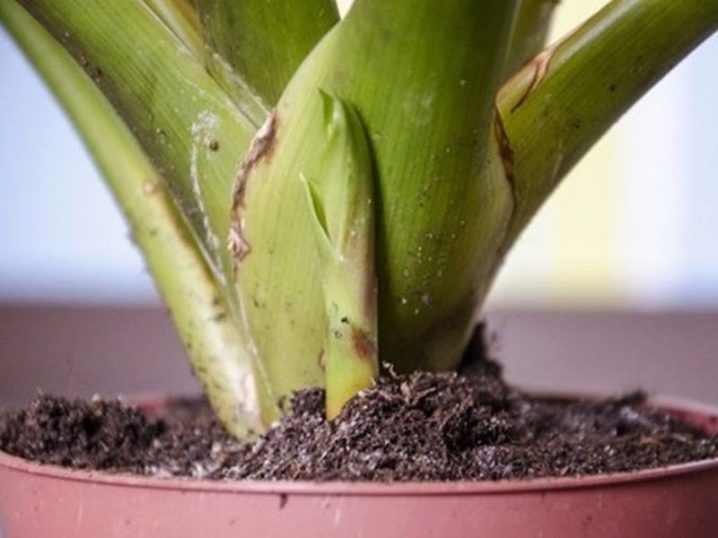
Any kind of guzmania blooms only once, which is why botanists call it an annual. However, it sometimes takes more than one year to wait for it to bloom. The faded Guzmania bush gradually begins to fade, after which it dies. The formed children on the sides of the mother's base are proposed to be seated in different containers.
Reproduction methods
The only way to prolong the life of the represented species of epiphytes is reproduction. When working and studying guzmania, botanists identified only two ways to increase the population:
- dividing the bush;
- jigging children.
In general, both processes are identical. As soon as the bush fades, it has lateral growths, hereinafter referred to as children. The parental outlet dies off after a while, and young embryos appear next to it, in which an individual root system is gradually formed.
The procedure for depositing babies is performed when the length of young roots is 2 cm.
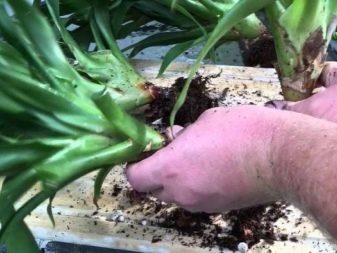
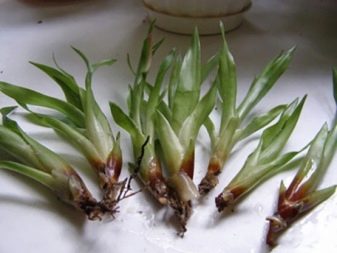
The baby is separated from the mother bush with a sharp, sterilized knife. The place of the cut on the bush and the separated process must be treated with a garden pitch. The process of root formation in children occurs at different rates. That is why it is impossible to transplant all embryos at the same time. Each individual shoot is transplanted into an individual container filled with a prepared soil mixture. Then the transplanted baby is placed in a warm place. At first, the transplanted shoot should be covered with a polyethylene cap capable of creating the required air humidity. When the bushes grow up and get stronger, they can be transplanted using the transshipment method mentioned earlier.
Guzmania propagation with the help of seeds is carried out not only by breeders, but also by lovers of home mini-gardens. The container prepared for sowing is filled with a substrate developed and manufactured for representatives of the bromeliad family. It contains sand and crushed peat. The seeds are pre-washed in a solution of potassium permanganate, after which they are well dried and evenly spread over the harvested soil mixture.
Seeds should not be pressed down, as they need constant access to lighting. After sowing, the container is covered with a film or glass and removed to a warm room, the temperature in which fluctuates within 24 degrees.
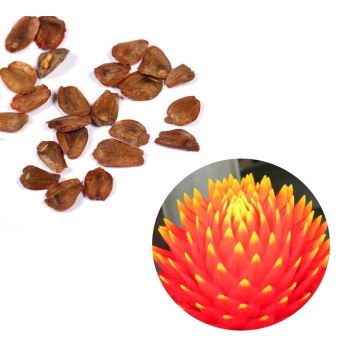
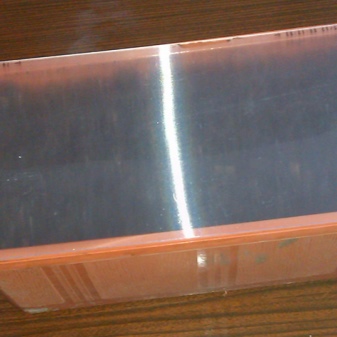
Do not forget about airing the room where the landings are located. The same applies to soil moisture. If necessary, the substrate can be sprayed with warm water from a spray bottle.
The first shoots will begin to show in 3 weeks. A pick should be done when the seedlings are 10 weeks old. Then, after half a month, the grown bushes are transplanted to a permanent place of residence. Blooming guzmania grown by sowing seeds can occur in about 5 years.
Flowering features
The most crucial stage in the life of Guzmania is the flowering period. This occurs around the fourth or fifth year after planting. As mentioned earlier, the stem of the flower is missing. Elongated leaves create a rosette, reminiscent of a tall wine glass, in the center of which a single peduncle with small leaves is formed. Colorful bracts appear on it, which are often confused with flowers. Due to its bright colors, guzmania attracts insects that pollinate it.
Despite the overall beauty of the plant, the flowers that appear during the flowering period do not have an attractive appearance, they are very small in size, and pale yellow in color, unnoticeable. But they spread an extraordinary and sensual aroma for several meters.
The blooming period of Guzmania begins in the spring, around March. The flowering time varies from 2 to 6 months. It all depends on the type of flower.
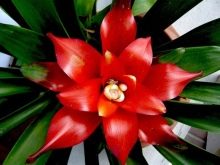

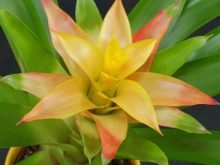
At this most important moment, guzmania must be carefully taken care of, to create comfortable conditions for her, and in return she will give a magical beauty, which no person can pass by. Unfortunately, as soon as the guzmania has faded, it dies. But under favorable living conditions, it leaves behind small shoots on the sides, which are amenable to transplantation and subsequent cultivation.
Quite rarely, but it happens that some flower growers simply do not bloom guzmania. But I really want to see this special flower at the peak of its life cycle. To understand why a plant does not want to bloom, you should consider some tips from experienced botanists and breeders.
- Most likely, the Guzmania do not like living conditions. She may not be satisfied with the dry climate in urban houses and apartments. For moistening, you should use a spray bottle with a fine nozzle, which allows you to spray not only the plant, but also soften the air space around it.
- It is necessary to carefully familiarize yourself with its location. The sun or the shady side does not make the guzman feel comfortable. The plant needs to grow in a shaded area so that only diffused light comes to it.
- The flower grower should not forget about the nutrition of the epiphytes. The activation of the peduncle is affected by foliar feeding. In the absence of it, you can use the most common apple. It should be placed in a flower pot and covered with a plastic bag. Five days of "apple atmosphere" will be enough for the plant. From the first minutes of sheltering, the apple will begin to secrete important and useful substances that can wake up the bud of flowering. The main thing is not to forget to monitor the condition of the fruit. The resulting mold on the surface of the apple can affect the general condition of the plant, as well as provoke the development of rot. If the apple starts to spoil, it should be replaced with a fresh one. Cut bananas or pears are used in a similar way.
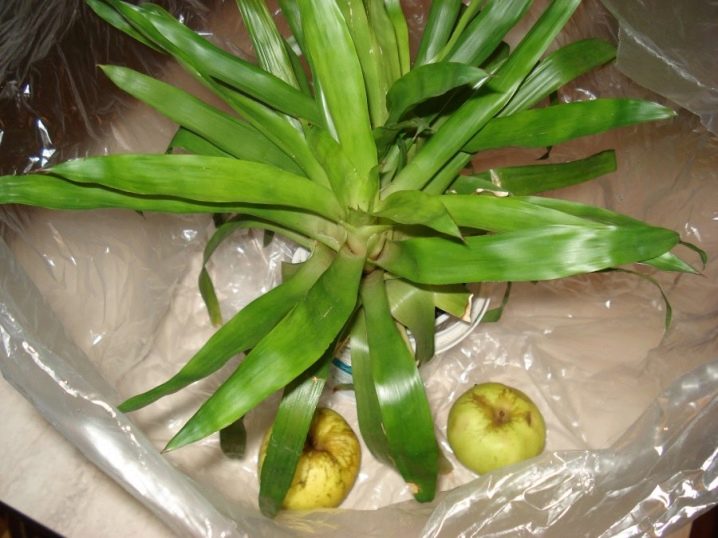
After waiting for flowering, it is important to remember that when spraying the bush, you should be careful not to fall on the bracts with drops, otherwise the flowering period will be significantly reduced.
Diseases and pests
Guzmania is an unpretentious plant, and yet it happens that it can get sick. This happens when the rules for keeping the flower are violated, improper watering, the use of cold water to feed the root system. To prepare in advance and know about the possible ailments of the plant, you should familiarize yourself with the tips of experienced flower growers.
- If gray spots appear on spreading and green leaves, then the plant was struck by gray rot. The disease is fungal but treatable. As a treatment, you must use a mixture of fungicide. Processing is done several times.
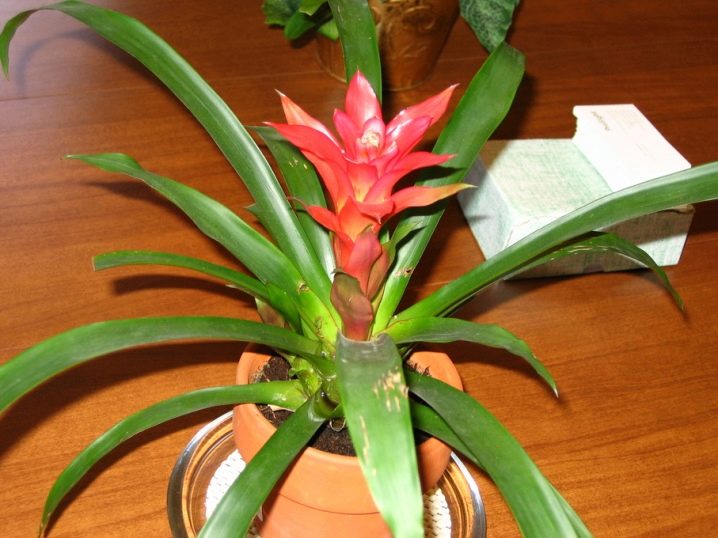
- Moisture oversaturation of the outlet can affect the wilting of the flower. In some cases, the root collar and base of the plant rots.

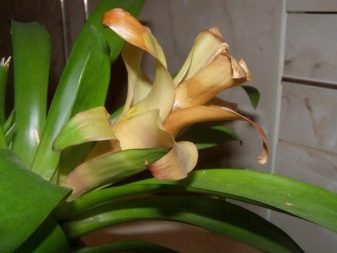
- Dry air, as well as the lack of liquid in the outlet lead to the fact that the spreading leaves of the guzmania dry up.
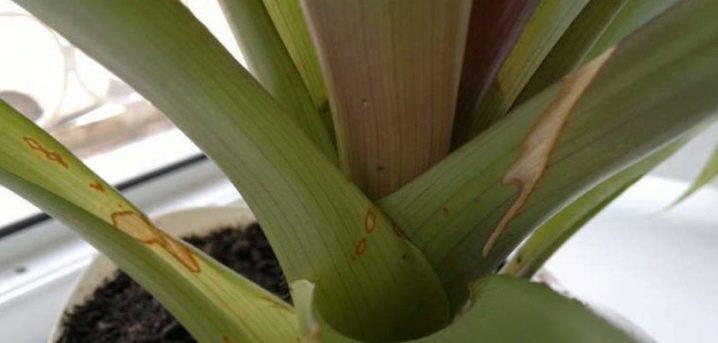
- Bright sun rays can burn the plant. Burns in guzmania appear as dry brown spots. Sometimes the tips of the leaf plate curl and dry out.
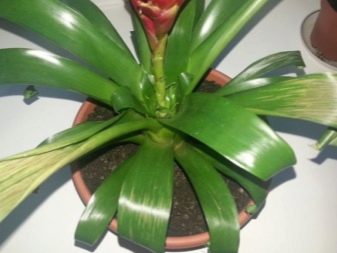
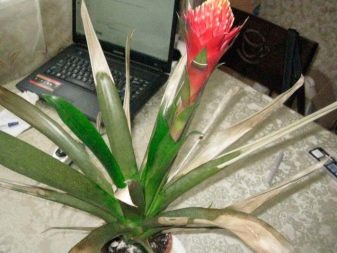
- When using hard water for spraying guzmania, a bloom appears on the leaves that resembles white lime.
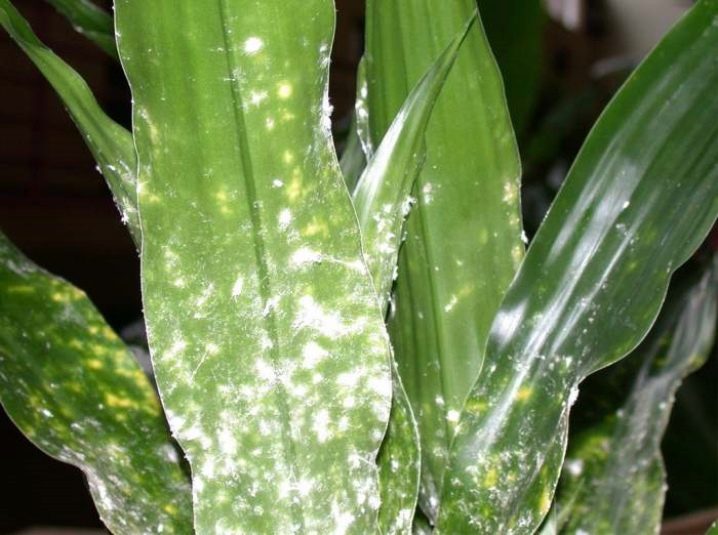
- Room temperature too low can adversely affect the general condition of the flower. The sheet plate becomes soft, causing the rosette to disintegrate.
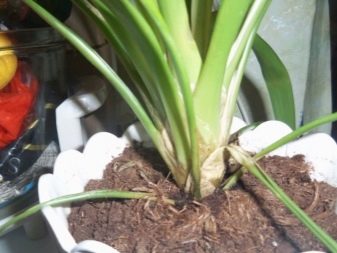
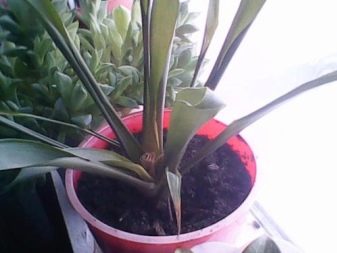
- Excessive watering of the substrate causes root rot... As a preventive measure, the flower will have to be removed, cut off the dead areas, and the wounds should be treated with a mixture of activated carbon. Then dry the bush and plant it in a new substrate.
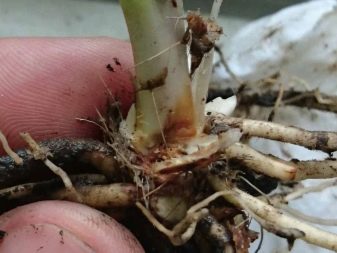
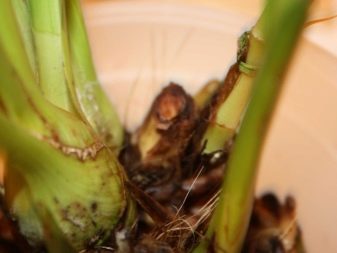
- Sometimes it happens that guzmania stops growing... Perhaps the florist did not feed the plant and soil for a long time. Either she does not have enough light or the air in the room is very dry.
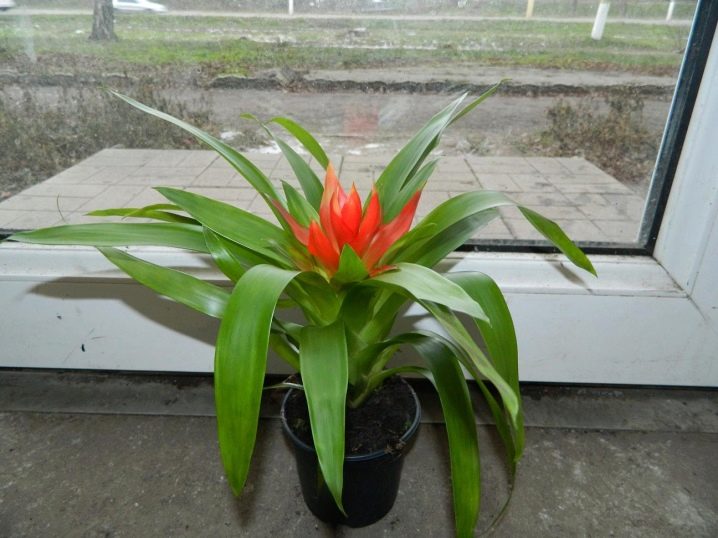
If at the end of flowering there are no childrenmost likely, this is due to the fact that the grower did not separate the peduncle, but waited for the seeds to ripen. Unfortunately, this process slows down the formation of processes. After the last flowering, the plant lives for some time. It is necessary to have time to cut the peduncle and wait for the emergence of children.
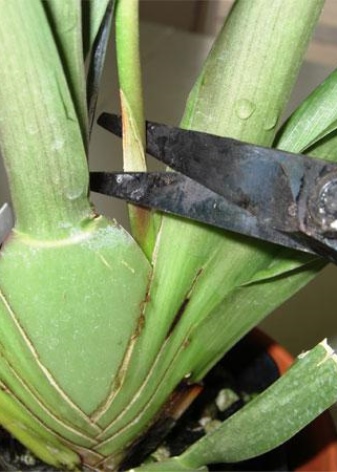
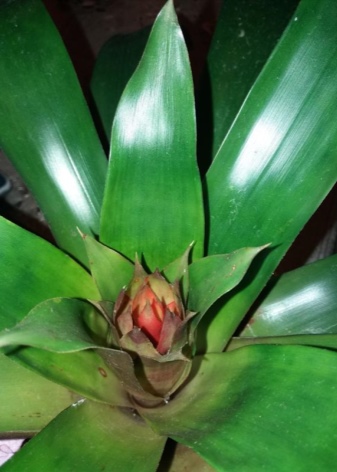
From the presented list of possible diseases, it becomes clear that with timely watering, quality care and decent lighting, the guzmania will not be able to pick up any ailment.
As for insects, guzmania, like any flower, is susceptible to attack by parasites. It sometimes attracts the attention of sucking species such as spider mites, mealybugs, or scale insects.
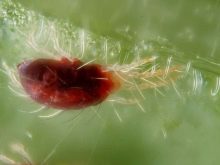

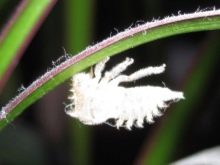
Their appearance is not difficult to determine. The leaves become spoiled, plaque appears on them, a thin cobweb. In cases of the appearance of harmful microorganisms, the leaves must be blotted with a cotton pad previously moistened with a solution of laundry soap. The plant itself will have to be sprayed with an insecticide, for example, "Aktar". "Aktellik" and "Fitoverm" have identical properties with it. You should not come up with ways to dilute drugs on your own. The instructions provided by the manufacturer detail the preparation method for each mixture used.

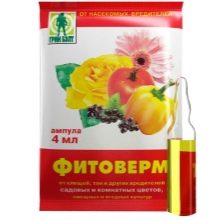

For the secrets of caring for guzmania, see the video presented.
























Wonderful. I found out what interested me. Thanks.
The comment was sent successfully.